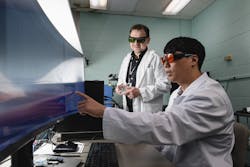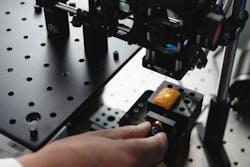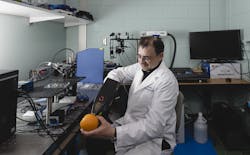Realizing food fraud is becoming a major concern worldwide, a team at Purdue University (West Lafayette, IN) is using laser-induced breakdown spectroscopy (LIBS) to authenticate different food samples—specifically determining the chemical structure and atomic composition. Economically motivated food adulteration (EMFA)—in which manufacturers replace more valuable, authentic ingredients with those that are cheaper; cutting olive oil with vegetable oil or using artificial vanilla rather than extract, for instance—is a growing problem LIBS can address. In fact, the technique is accurate enough to determine ingredients used, how the food was prepared, and potentially even its point of origin (see video).
“There is a strong correlation between food safety and food fraud, with food contamination often directly resulting from bad practices associated with EMFA,” says Bartek Rajwa, a professor of computational biology at Purdue.
While a biophysicist, computational biologist, and bioinformatician by training and trade, Rajwa helps food scientists with various projects that require data science input. This current LIBS-involved study is essentially a spin-off of other work he is part of that relates to food safety, contamination, authentication, and detection of foodborne pathogens.
“The ability to deploy easy-to-use, inexpensive food analysis systems that can utilize the power of modern analytical chemistry and data processing to uncover food fraud or detect contamination and adulteration would have a pretty broad impact on agriculture and the food industry,” Rajwa says.
Proving the power of LIBS
In their study, the Purdue researchers use handheld LIBS equipment to demonstrate its performance in the specific context of food authentication (see Fig. 1). The team focused on agricultural commodities—European Alpine-style cheeses including Gruyère, as well as coffee, various spices, balsamic vinegar, and vanilla extracts. The liquid samples, measured on a nitrocellulose membrane, required minimal preparation; the solid foods required none.
LIBS differentiated real vanilla extract from imitation vanilla flavoring with 99% accuracy. The technique produced 90% accuracy in identifying authentic Gruyère vs. a similar-style cheese product.
“At the point of interrogation, the ablated sample undergoes plasma formation,” Rajwa says. “The energy emitted as light during the cooldown of the plasma is then analyzed to identify and measure the elemental makeup of the sample.”
Pre-processed and standardized LIBS spectra were used to train and test the elastic net-regularized multinomial classifier, according to the study. Ultimately, field-deployable, portable LIBS devices proved to be robust, accurate, simple-to-use platforms for agricultural product verification (see Figs. 2 and 3).
LIBS vs. the rest
Minimal-to-no sample preparation is a selling point for LIBS. “In some cases, samples can be analyzed directly without the need for extensive extraction or pretreatment,” Rajwa says. “This is important for the portability of the analytical system. This is not always the case for other spectroscopy systems.”
Speed is another highlight for LIBS. It provides real-time results, often within seconds, which is particularly advantageous for high-throughput analysis of large sample sets as well as in-field analysis and portability. LIBS can also analyze different elements in a food sample simultaneously for a more comprehensive view than is possible with other methods.
“LIBS excels at elemental analysis, providing information about the elemental composition of samples,” Rajwa says, noting this is crucial for identifying trace elements and contaminants in foods. And as it’s nondestructive with most samples, scientists can analyze delicate or valuable samples without altering their integrity.
Other optical spectroscopy approaches have aided food analysis, Rajwa says, the most established of which is infrared (IR) spectroscopy, which can identify functional chemical groups and analyze molecular structures in food components, such as proteins, fats, and carbohydrates. Ultraviolet-visible (UV-Vis) spectroscopy is an established approach, which can quantify specific compounds and determine the presence of pigments, additives, and some contaminants.
Neither of these techniques are foolproof or completely reliable when it comes to this type of food analysis. Rather, they can be difficult and are generally very expensive to implement and use.
Raman spectroscopy is another commonly used method for food analysis, measuring the interaction between light scattering and molecular vibrations in a sample. Rajwa says it’s “quite valuable for analyzing molecular structures and identifying compounds in complex matrices.” Alone, this technique isn’t the most effective for food analysis, however, but it could someday enhance the overall LIBS approach.
The future of LIBS
As the research continues, Rajwa says his team is working to create a set of sample analysis protocols that cover all aspects of food analysis, from hardware and sample preparation to chemometrics and data science. “Our immediate goal is to develop new tools that will benefit the agriculture and food processing industries as well as regulatory bodies,” he says.
Long term, the team wants to help improve the quality and safety of food products in the U.S. and internationally. This could potentially involve combining LIBS with Raman spectroscopy—it’s a pairing that may provide a more detailed and comprehensive analysis of food products.
“LIBS is great for identifying the element-based fingerprint of a sample, while Raman can provide molecular information by measuring the vibrational modes of molecules,” Rajwa says. “Together, these two techniques offer a comprehensive understanding of the quality and safety of food products, allowing for a more precise analysis of their characteristics.”
From the chemical perspective, Rajwa adds, Raman spectroscopy can identify functional groups, molecular structures, and specific compounds present in the sample. LIBS can provide information about elemental composition.
“The complementary nature of these two techniques offers a powerful tool for examining the subtle differences in the composition of different products,” Rajwa says. “That’s what we want to leverage.”
The team’s work could ultimately enable rapid and accurate identification of fraudulent products at various points along the supply chain—from farms to markets and warehouses to retailers and restaurants. Doing so would, in turn, “deter food fraudsters from engaging in deceptive practices,” Rajwa says, as they would face a higher risk of detection and prosecution. “This could also support the development and enforcement of food safety standards and regulations, both nationally and internationally.”
About the Author
Justine Murphy
Multimedia Director, Digital Infrastructure
Justine Murphy is the multimedia director for Endeavor Business Media's Digital Infrastructure Group. She is a multiple award-winning writer and editor with more 20 years of experience in newspaper publishing as well as public relations, marketing, and communications. For nearly 10 years, she has covered all facets of the optics and photonics industry as an editor, writer, web news anchor, and podcast host for an internationally reaching magazine publishing company. Her work has earned accolades from the New England Press Association as well as the SIIA/Jesse H. Neal Awards. She received a B.A. from the Massachusetts College of Liberal Arts.



